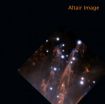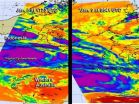(Press-News.org) A new image released today reveals how Gemini Observatory's most advanced adaptive optics (AO) system will help astronomers study the universe with an unprecedented level of clarity and detail by removing distortions due to the Earth's atmosphere. The photo, featuring an area on the outskirts of the famous Orion Nebula, illustrates the instrument's significant advancements over previous-generation AO systems.
"The combination of a constellation of five laser guide stars with multiple deformable mirrors allows us to expand significantly on what has previously been possible using adaptive optics in astronomy," said Benoit Neichel, who currently leads this adaptive optics program for Gemini. "For years our team has focused on developing this system, and to see this magnificent image, just hinting at its scientific potential, made our nights on the mountain - while most folks were celebrating the New Year's holiday - the best celebration ever!"
The new system, called GeMS, is installed on the Gemini South telescope in Chile and is the first of its kind to use laser guide stars and a technology called Multi-Conjugate Adaptive Optics (MCAO) to image the sky. Motivated by MCAO's potential to produce a significantly larger field-of-view and more uniform corrections than previous AO systems, former Gemini scientist François Rigaut (now at the Australian National University), first suggested the system's development at Gemini over 10 years ago. According to Rigaut, "It's a great feeling to see this system on the sky and doing cutting-edge science. When it's all theoretical you dream of what it will someday do to improve our vision of the cosmos. An image like this makes it so real - it's worth all the mental sweat!"
"Adaptive optics allows ground-based telescopes to take full advantage of their large mirrors," notes Dr. Gary Schmidt, Gemini program director for the U.S. National Science Foundation. "Gemini's development of MCAO leads the world, and its fidelity even surpasses that of current – and far more expensive – orbiting observatories for imaging the sky."
This milestone also bodes well for future generations of large ground-based telescopes. "As telescopes get larger they look through more and more of the Earth's atmosphere and this is a problem," said Gary Sanders, Project Manager of the 30-Meter Telescope (TMT) Project. Sanders emphasizes that it is imperative that we find new and innovative ways to solve this problem by removing the distortions caused by the turbulent air overhead. "MCAO is a key technology that makes the next generation of large telescopes, like the TMT, justifiable. It allows us to use the light we collect more efficiently and see the universe more sharply than ever before in human history," said Sanders.
About five years ago, when GeMS was under development, and still just a vision for Rigaut and the team, Gemini Observatory released an image of a smaller section of this area of the Orion Nebula known as the "Orion Bullets." That image demonstrated the power of Gemini's AO system called Altair - which is still actively used at the Gemini North telescope. Gemini's instrument scientist for Altair, Chad Trujillo, points out that in one shot GeMS covers a significantly larger field-of-view than Altair and, he adds, "The uniformity and performance across the image is amazing! In this new image, the pixels are 2.5 times finer and there are about 16 times more of them. Both the correction quality and the field-of-view are considerably better than the previous generation of AO systems."
THE MCAO ADVANTAGE
The technology behind MCAO involves the use of multiple laser guide stars (five in the GeMS system) and several deformable mirrors (three in all) to sample atmospheric distortions and cancel them out in real-time as imaging data is collected. Using algorithms similar to those developed for medical tomographic imaging the GeMS MCAO system creates a three-dimensional snapshot of atmospheric turbulence about 500 to 1000 times per second. The result is about a 16-fold increase in the patch of sky observed, while providing uniform corrections over the entire field. "This is huge when it's time for astronomers to reduce their data," said Adam Ginsburg a graduate student working with John Bally at the University of Colorado who originally proposed that the GeMS system revisit the Orion bullets. "If the corrections are not uniform across the entire field it is difficult, and sometimes impossible, for researchers to compare one part of a dataset with another and errors proliferate," said Ginsbrug. Bally adds that MCAO should make this problem a non-issue.
GeMS, in conjunction with the Gemini South Adaptive Optics Imager (GSAOI), is undergoing commissioning and has obtained some early System Verification data. About 80 hours have been offered for the first semester of 2013, and more will be available in the second semester, for astronomers in the international partnership through the standard Gemini proposal process.
THE ORION BULLETS
Discovered in 1983, the Orion Bullets are clumps of gas ejected from deep within the Orion Nebula - located some 1500 light-years from our Solar System. The violence causing this is likely related to the recent formation of a cluster of massive stars with strong winds that can expel gas at supersonic speeds. The bullets (seen as distinctive blue features in the new Gemini image) are actually quite large, about 10 times the size of Pluto's orbit around the Sun.
As the bullets speed outward, they leave behind distinctive tubular and cone-shaped wakes, which shine like tracers due to the bullets heating of the molecular hydrogen gas in the Orion Nebula. The wakes span much greater distances than the bullets, measuring as much as a fifth of a light-year in length. As Gemini first observed with Altair, the fingerlike wakes also resolve into filaments which are clearly resolved in the new Gemini GeMS image.
INFORMATION:
Next-generation adaptive optics brings remarkable details to light in stellar nursery
The image release was revealed this Wednesday at the AAS meeting in Long Beach, Calif.
2013-01-10
ELSE PRESS RELEASES FROM THIS DATE:
Microscopic blood in urine unreliable indicator of urinary tract cancer
2013-01-10
Rochester, MN, January 9, 2013 – Microscopic amounts of blood in urine have been considered a risk factor for urinary tract malignant tumors. However, only a small proportion of patients referred for investigation are subsequently found to have cancer. A new Kaiser Permanente Southern California study published in the February Mayo Clinic Proceedings reports on the development and testing of a Hematuria Risk Index to predict cancer risk. This could potentially lead to significant reductions in the number of unnecessary evaluations.
Individuals with microscopic hematuria ...
Small price differences can make options seem more similar, easing our buying decisions
2013-01-10
Some retailers, such as Apple's iTunes, are known for using uniform pricing in an effort to simplify consumers' choices and perhaps increase their tendency to make impulse purchases. But other stores, like supermarkets, often have small price differences across product flavors and brands.
As counterintuitive as it might seem, these small price differences may actually make the options seem more similar, according to new research published in Psychological Science, a journal of the Association for Psychological Science. The research shows that adding small differences ...
Online message boards provide outlets for mothers' concerns, MU researcher says
2013-01-10
COLUMBIA, Mo. –Parenting infants and toddlers can be challenging, and for generations, mothers have turned to other moms for advice. Now, with the availability of the Internet, mothers are consulting each other using modern venues: online message boards. Research from the University of Missouri indicates online discussion boards provide safe environments for mothers to anonymously express child-rearing concerns and receive support from other moms.
"Mothers have feelings that they might be embarrassed to talk about face-to-face with someone," said Jean Ispa, professor ...
Invading species can extinguish native plants despite recent reports
2013-01-10
TORONTO, ON – Ecologists at the University of Toronto and the Swiss Federal Institute of Technology Zurich (ETH Zurich) have found that, given time, invading exotic plants will likely eliminate native plants growing in the wild despite recent reports to the contrary.
A study published in Proceedings of the National Academy of Sciences (PNAS) reports that recent statements that invasive plants are not problematic are often based on incomplete information, with insufficient time having passed to observe the full effect of invasions on native biodiversity.
"The impacts ...
Engineering alternative fuel with cyanobacteria
2013-01-10
ALBUQUERQUE, N.M. — Sandia National Laboratories Truman Fellow Anne Ruffing has engineered two strains of cyanobacteria to produce free fatty acids, a precursor to liquid fuels, but she has also found that the process cuts the bacteria's production potential.
Micro-algal fuels might be one way to reduce the nation's dependence on foreign energy. Such fuels would be renewable since they are powered by sunlight. They also could reduce carbon dioxide emissions since they use photosynthesis, and they could create jobs in a new industry. President Barack Obama, speaking in ...
High fiber diet prevents prostate cancer progression
2013-01-10
A high-fiber diet may have the clinical potential to control the progression of prostate cancer in patients diagnosed in early stages of the disease.
The rate of prostate cancer occurrence in Asian cultures is similar to the rate in Western cultures, but in the West, prostate cancer tends to progress, whereas in Asian cultures it does not. Why? A University of Colorado Cancer Center study published in the January 2013 issue of the journal Cancer Prevention Research shows that the answer may be a high-fiber diet.
The study compared mice fed with of inositol hexaphosphate ...
Dark energy alternatives to Einstein are running out of room
2013-01-10
Research by University of Arizona astronomy professor Rodger Thompson finds that a popular alternative to Albert Einstein's theory for the acceleration of the expansion of the universe does not fit newly obtained data on a fundamental constant, the proton to electron mass ratio.
Thompson's findings, reported Jan. 9 at the American Astronomical Society meeting in Long Beach, Calif., impact our understanding of the universe and point to a new direction for the further study of its accelerating expansion.
To explain the acceleration of the expansion of the universe, astrophysicists ...
NASA sees Tropical Cyclone Narelle intensifying
2013-01-10
Infrared and near-infrared NASA satellite imagery provided signs to forecasters that Tropical Cyclone Narelle is intensifying as it moves southwest paralleling Western Australia coastline. Warnings have been posted as Narelle nears.
The Australian Bureau of Meteorology (ABM) issued the following watch and warnings for Narelle on Jan. 9: A cyclone watch is in effect for coastal areas from Whim Creek to Coral Bay. A Blue alert is in effect for coastal and island communities from Whim Creek to Mardie, including Wickham, Roebourne, Point Sampson, Karratha and Dampier.
The ...
Protective communities may reduce risk of drinking in teens
2013-01-10
UNIVERSITY PARK, Pa. -- Living in a caring community may help curb teenage alcohol use, while hanging out with antisocial peers can have the opposite effect, according to Penn State researchers studying substance abuse patterns.
The researchers evaluated how seven different categories of risk and protective factors predicted teen alcohol use. Risk factors included antisocial attitudes, antisocial behaviors, association with antisocial peers and family risk. Protective factors were positive community experiences, positive school experiences and family strengths.
Damon ...
Mussels inspire innovative new adhesive for surgery
2013-01-10
UNIVERSITY PARK, Pa. -- Mussels can be a mouthwatering meal, but the chemistry that lets mussels stick to underwater surfaces may also provide a highly adhesive wound closure and more effective healing from surgery.
In recent decades bioahesives, tissue sealants and hemostatic agents became the favored products to control bleeding and promote tissue healing after surgery. However, many of them have side effects or other problems, including an inability to perform well on wet tissue.
"To solve this medical problem, we looked at nature," said Jian Yang, associate professor ...
LAST 30 PRESS RELEASES:
This new understanding of T cell receptors may improve cancer immunotherapies
A new fossil face sheds light on early migrations of ancient human ancestor
A new immunotherapy approach could work for many types of cancer
A new way to diagnose deadly lung infections and save lives
40 percent of MRI signals do not correspond to actual brain activity
How brain-inspired algorithms could drive down AI energy costs
Gum disease may be linked to plaque buildup in arteries, higher risk of major CVD events
Contrails are a major driver of aviation’s climate impact
Structure of dopamine-releasing neurons relates to the type of circuits they form for smell-processing
Reducing social isolation protects the brain in later life
Keeping the heart healthy increases longevity even after cancer
Young adults commonly mix cannabis with nicotine and tobacco
Comprehensive review illuminates tau protein's dual nature in brain health, disease, and emerging psychiatric connections
Book prepares K-12 leaders for the next public health crisis
Storms in the Southern Ocean mitigates global warming
Seals on the move: Research reveals key data for offshore development and international ecology
Sports injuries sustained during your period might be more severe
World's first successful 2 Tbit/s free-space optical communication using small optical terminals mountable on satellites and HAPS
Can intimate relationships affect your heart? New study says ‘yes’
Scalable and healable gradient textiles for multi‑scenario radiative cooling via bicomponent blow spinning
Research shows informed traders never let a good climate crisis go to waste
Intelligent XGBoost framework enhances asphalt pavement skid resistance assessment
Dual-function biomaterials for postoperative osteosarcoma: Tumor suppression and bone regeneration
New framework reveals where transport emissions concentrate in Singapore
NTP-enhanced lattice oxygen activation in Ce-Co catalysts for low-temperature soot combustion
Synergistic interface engineering in Cu-Zn-Ce catalysts for efficient CO2 hydrogenation to methanol
COVID-19 leaves a lasting mark on the human brain
Scientists use ultrasound to soften and treat cancer tumors without damaging healthy tissue
Community swimming program for Black youth boosts skills, sense of belonging, study finds
Specific depressive symptoms in midlife linked to increased dementia risk
[Press-News.org] Next-generation adaptive optics brings remarkable details to light in stellar nurseryThe image release was revealed this Wednesday at the AAS meeting in Long Beach, Calif.



